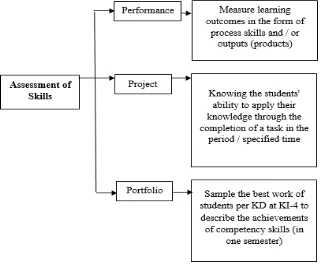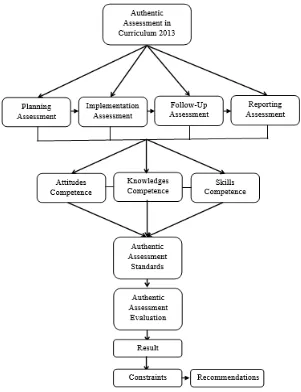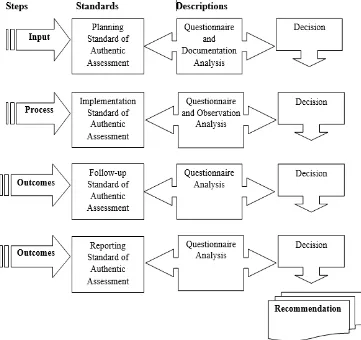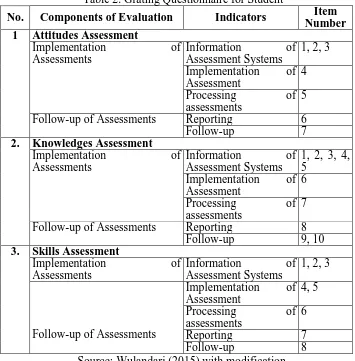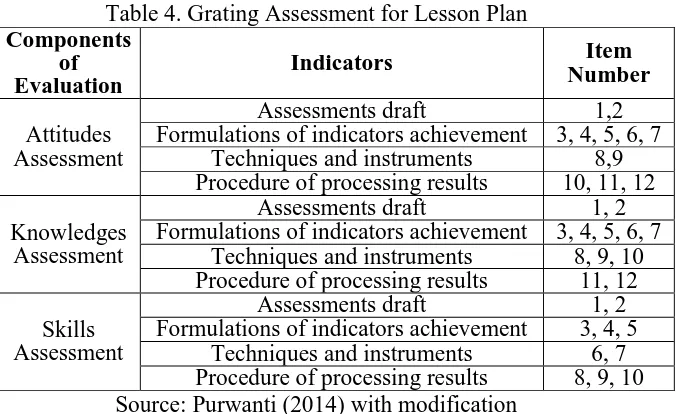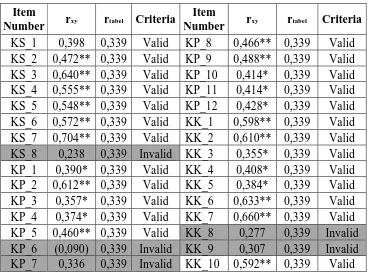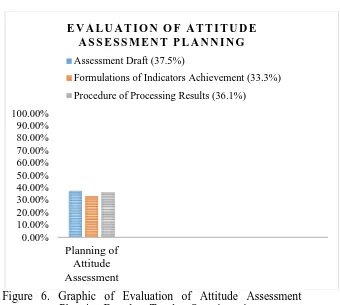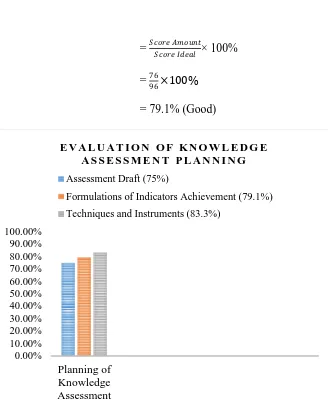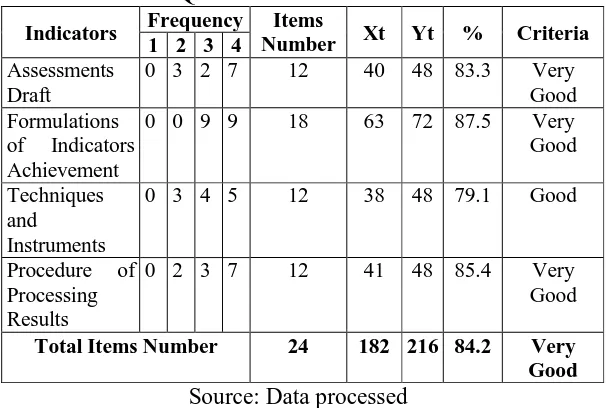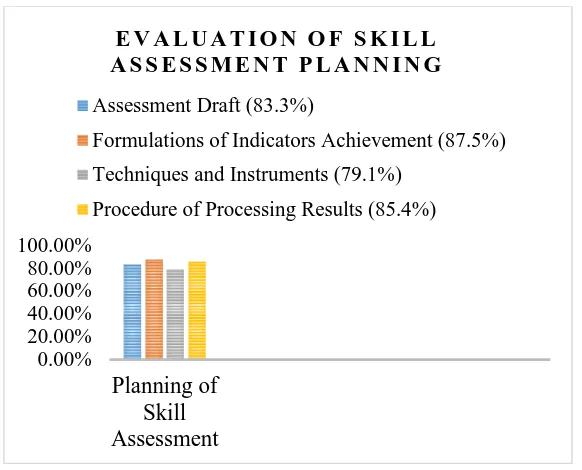EVALUATION OF AUTHENTIC ASSESSMENT IN THE IMPLEMENTATION OF CURRICULUM 2013
AT ACCOUNTING DEPARTMENT OF SMK NEGERI 1 PENGASIH
UNDERGRADUATE THESIS
This undergraduate thesis is submitted to fulfil a part of the requirement to obtain the degree of Bachelor of Education in Faculty of Economics
Yogyakarta State University
By:
PRIMA MEDIANA NUANSARATRI 13803241067
ACCOUNTING EDUCATION DEPARTMENT FACULTY OF ECONOMICS
v
MOTTO AND DEDICATION
MOTTO
“Verily, along with every hardship is relief. Along with every hardship is relief.”
(QS. Al Insyirah 94: 5-6)
DEDICATION
The name of Allah SWT the Most Gracious, Most Merciful, praise the presence of Allah SWT who has so many valuable things that I have without ever separated from
the many conveniences You give. Prayers and greetings is always devoted to the great prophet Rasulullah SAW.
From the sincere heart, I dedicate this work to: Saleh Riyadi (Father)
Thank you for an unlimited time to guide me
Thank you for the love that never could be portrayed in your activity
Noor Hidayati (Mother) Thank you for the prayer never floated Thank you for the love that will never destroyed
Sujiyem and Siti Kawatijah (Grand Mother) Thank you for the prayers and good wishes for me Thank you for the motivation and spirit on every meeting
Pristyanti Rahmat Jati (Sister)
Thank you for the motivation, spirit, prayer, and smile on every meeting
Alma mater
vi
EVALUATION OF AUTHENTIC ASSESSMENT IN THE IMPLEMENTATION OF CURRICULUM 2013 AT
ACCOUNTING DEPARTMENT OF Department of SMK Negeri 1 Pengasih.
Six teacher and 123 students on Accounting Department of SMK Negeri 1 Pengasih are the respondent on this research. Data collection technique uses questionnaire, observation, and documentation. Validity and reliability of questionnaire have been measure before. Score obtained were analyzed using quantitative description analysis then convert into percentage and categorized according to criteria scale.
Results of this research are (1) Planning of authentic assessment by teacher on Accounting Department of SMK Negeri 1 Pengasih based on teacher questionnaire get percentage 66.1% and included on Good category, meanwhile based on documentation sheet get percentage 75.4% and included on Good category, (2) Implementation of authentic assessment by teacher on Accounting Department of SMK Negeri 1 Pengasih based on teacher questionnaire get percentage 66.6% and included on Good category, meanwhile based on student questionnaire get percentage 73.6% and included on Good category, (3) Follow-up of authentic assessment by teacher on Accounting Department of SMK Negeri 1 Pengasih based on teacher questionnaire get percentage 67.1% and included on Good category, meanwhile based on student questionnaire get percentage 64.3% and included on Good category, (4) Reporting of authentic assessment by teacher on Accounting Department of SMK Negeri 1 Pengasih based on teacher questionnaire get percentage 68% and included on Good category, meanwhile based on student questionnaire get percentage 79.2% and included on Good category.
vii
EVALUASI PENILAIAN AUTENTIK DALAM IMPLEMENTASI KURIKULUM 2013 PADA JURUSAN PENDIDIKAN AKUNTANSI
DI SMK NEGERI 1 PENGASIH
Oleh:
PRIMA MEDIANA NUANSARATRI 13803241067
ABSTRAK
Penelitian ini dilaksankan untuk mengevaluasi penilaian autentik dalam implementasi kurikulum 2013 yang dilaksanakan oleh guru di Jurusan Akuntansi SMK Negeri 1 Pengasih.
Enam guru dan 123 siswa di Jurusan Akuntansi SMK Negeri 1 Pengasih adalah responden dalam penelitian ini. Teknik pengumpulan data yang digunakan adalah kuesioner, observasi, dan dokumentasi. Validitas dan reliabilitas kuesioner telah diukur sebelumnya. Skor yang diperoleh dinalisis menggunakan analisis kuantitatif deskriptif kemudian diubah ke dalam bentuk persentase dan dikategorikan berdasarkan skala kriteria.
Hasil dari penelitian ini adalah (1) Perencanaan penilaian autentik oleh guru di Jurusan Akuntansi SMK Negeri 1 Pengasih berdasarkan kuesioner guru memperoleh persentase sebesar 66.1% dan termasuk dalam kategori Baik, sedangkan berdasarkan lembar dokumentasi memperoleh persentase sebesar 75.4% dan termasuk dalam kategori Baik, (2) Implementasi penilaian autentik oleh guru di Jurusan Akuntansi SMK Negeri 1 Pengasih berdasarkan angket guru mendapatkan persentase sebesar 66.6% dan termasuk dalam kategori Baik, sedangkan berdasarkan kuesioner siswa memperoleh persentase sebesar 73.6% dan termasuk dalam kategori Baik, (3) Tindak lanjut penilaian autentik oleh guru di Jurusan Akuntansi SMK Negeri 1 Pengasih berdasarkan kuesioner guru mendapatkan persentase sebesar 67.1% dan termasuk dalam kategori Baik, sedangkan berdasarkan angket siswa mendapatkan persentase sebesar 64.3% dan termasuk dalam kategori Baik, (4) pelaporan penilaian autentik oleh guru di Jurusan Akuntansi SMK Negeri 1 Pengasih berdasarkan angket guru mendapatkan persentase sebesar 68% dan termasuk dalam kategori Baik, sedangkan berdasarkan angket guru mendapatkan persentase sebesar 79.2% dan termasuk dalam kategori Baik.
viii FOREWORD
First of all, I would like to thank Allah SWT the almighty for all the bless, mercy, and guidance, thus the Undergraduate Thesis entitled “Evaluation of Authentic Assessment in The Implementation of Curriculum 2013 at Accounting Department of SMK Negeri 1 Pengasih” can be finished. On this occasion with great humility, I would like to thank you to all of those who have given me help and guidance so that this can be finished. Completion of writing of this thesis, the author would like to thank to:
1. Prof. Dr. Rochmat Wahab, M.Pd., M.A., Rector of Yogyakarta State University. 2. Dr. Sugiharsono, M. Si., Dean of Faculty of Economics Yogyakarta State
University.
3. Rr. Indah Mustikawati, S.E., Akt., M. Si., The Head of Accounting Education Department Yogyakarta State University.
4. Dr. Denies Priantinah, S.E., M.Si., Akt., C.A., my supervisor who has been gives the best guidance to write a quality content of the thesis until finished.
5. Diana Rahmawati, M. Si., my first academic supervisor who has been gives the support and motivation.
6. Mimin Nur Aisyah, M. Sc., Ak., my second academic supervisor who has been gives support and motivation.
x
DECLARATION OF AUTHENTICITY ... iv
MOTTO AND DEDICATION ... v
CHAPTER II LITERATURE REVIEW ... 12
A. Theoritical Review ... 12
1. Evaluation ... 12
a. Definition of Evaluation ... 12
b. Evaluation of Learning Outcomes ... 13
2. Curriculum 2013... 14
a. Characteristic of Curriculum 2013 ... 14
xi
Page
3. Assessment of Learning Outcomes ... 17
a. Definition and Function of Assessment of learning Outcomes . 17 b. Mechanism of Learning Outcomes Assessment ... 18
4. Authentic Assessment in Curriculum 2013 ... 21
a. Definition of Authentic Assessment... 21
b. Characteristics of Authentic Assessment ... 22
5. Authentic Assessment in Vocational High School... 23
a. Assessment of Attitude Competence ... 23
b. Assessment of Knowledge Competence ... 26
c. Assessment of Skill Competence ... 27
6. Assessment Standards in Curriculum 2013 ... 28
a. Planning standards of Authentic Assessment ... 30
b. Implementation Standards of Authentic Assessment ... 33
c. Follow-up Standards of Authentic Assessment... 38
d. Reporting Standards of Authentic Assessment ... 40
7. Standards of Syllabus and Lesson Plan ... 40
B. Relevant Research ... 43
C. Framework... 45
D. Research Questions ... 47
CHAPTER III RESEARCH METHODS ... 48
A. Research Design ... 48
B. Place and Time of Research ... 49
C. Population and Sample of Research ... 50
D. Operational Definition of Variable ... 51
E. Data Collection Techniques ... 53
F. Research Instruments ... 55
G. Validity and Reliability of Instruments ... 58
H. Data Analysis Techniques ... 62
CHAPTER IV RESULT AND DISCUSSION ... 64
A. Result of Research ... 64
1. School Profile ... 64
2. Evaluation of Authentic Assessment ... 64
a. Antecedent Phase ... 65
b. Transaction Phase ... 94
xii
Page
B. Discussion ... 142
1. Antecedent Phase ... 142
2. Transaction Phase ... 146
3. Outcomes Phase ... 151
C. Limitation of Research ... 160
CHAPTER V CONCLUSION AND RECOMMENDATION ... 161
A. Conclusion ... 161
B. Recommendation ... 162
REFERENCES ... 164
xiii
LIST OF TABLE
Table Page
1. Range Rating ... 17
2. Grating Questionnaire of Student ... 56
3. Scoring Guidelines of Questionnaire ... 56
4. Grating Assessment for Lesson Plan ... 57
5. Scoring Guideline of Documentation Sheet ... 57
6. Validity on Interpretation of Student Questionnaire... 60
7. Validity Analysis of Student Questionnaire ... 60
8. Reliability Scale ... 61
9. Assessment Categories ... 63
10.Data of Attitude Assessment Planning Based on Teacher Questionnaire 67 11.Evaluation of Attitude Assessment Planning Based on Teacher Questionnaire ... 68
12.Data of Knowledge Assessment Planning Based on Teacher Questionnaire 72 13.Evaluation of Knowledge Assessment Planning based on Teacher Questionnaire ... 72
14.Data of Skill Assessment Planning Based on Teacher Questionnaire ... 76
15.Evaluation of Skill Assessment Planning Based on Teacher Questionnaire ... 77
16.Data of Attitude Assessment Planning based on Documentation Sheet .. 81
17.Evaluation of Attitude Assessment Planning Based on Documentation Sheet ... 82
18.Data of Knowledge Assessment Planning Based on Documentation Sheet ... 85
19.Evaluation of Knowledge Assessment Planning based on Documentation Sheet ... 86
20.Data of Skill Assessment Planning Based on Documentation Sheet ... 90
21.Evaluation of Skill Assessment Planning Based on Documentation Sheet ... 91
22.Data of Attitude Assessment Implementation Based on Teacher Questionnaire ... 96
23.Evaluation of Attitude Assessment Implementation Based on Teacher Questionnaire ... 96
xiv
Table Page
25.Evaluation of Knowledge Assessment Implementation Based on Teacher Questionnaire ... 100 26.Data of Skill Assessment Implementation Based on Teacher
Questionnaire ... 103 27.Evaluation of Skill Assessment Implementation Based on Teacher
Questionnaire ... 104 28.Evaluation of Attitude Assessment Implementation Based on Student
Questionnaire ... 107 29.Evaluation of Knowledge Assessment Implementation Based on Student
Questionnaire ... 111 30.Evaluation of Skill Assessment Implementation Based on Student
Questionnaire ... 115 31.Data of Follow-up of Attitude Assessment Based on Teacher
Questionnaire ... 119 32.Evaluation of Follow-up of Attitude Assessment Based on Teacher
Questionnaire ... 119 33.Data of Follow-up of Knowledge Assessment Based on Teacher
Questionnaire ... 121 34.Evaluation of Follow-up of Knowledge Assessment Based on Teacher
Questionnaire ... 121 35.Data of Follow-up Skill Assessment Based on Teacher Questionnaire .. 123 36.Evaluation of Follow-up of Skill Assessment Based on Teacher
Questionnaire ... 123 37.Evaluation of Follow-up of Attitude Assessment Based on Student
Questionnaire ... 125 38.Evaluation of Follow-up of Knowledge Assessment Based on Student
Questionnaire ... 127 39.Evaluation of Follow-up of Skill Assessment Based on Student
Questionnaire ... 129 40.Data of Reporting Report of Attitude Assessment Based on Teacher
Questionnaire ... 131 41.Evaluation of Reporting of Attitude Assessment Based on Teacher
Questionnaire ... 131 42.Data of Reporting of Knowledge Assessment Based on Teacher
xv
Table Page
45.Evaluation of reporting of Skill Assessment Based on Teacher
Questionnaire ... 135 46.Evaluation of Reporting of Attitude Assessment Based on Student
Questionnaire ... 137 47.Evaluation of Reporting of Knowledge Assessment Based on Student
Questionnaire ... 139 48.Evaluation of Reporting of Skill Assessment Based on Student
Questionnaire ... 141 49.Evaluation Data of Antecedent Phase Based on Teacher Questionnaire and
Documentation Sheet ... 143 50.Evaluation Data of Transaction Phase Based on Teacher Questionnaire and
Student Questionnaire ... 148 51.Evaluation of Follow-up of Authentic Assessment Based on Teacher
Questionnaire and Student Questionnaire ... 153 52.Evaluation of Reporting of Authentic Assessment Based on Teacher
xvi
LIST OF FIGURES
Figure Page
1. Frame of Attitude Assessment ... 25 2. Frame of Knowledge Assessment ... 27 3. Frame of Skill Assessment ... 28 4. Frame of Authentic Assessment in The Implementation of Curriculum
2013 ... 46 5. Design of Evaluation ... 49 6. Graphic of Evaluation of Attitude Assessment Planning Based on
Teacher Questionnaire ... 69 7. Graphic of Evaluation of Knowledge Assessment Planning Based on
Teacher Questionnaire ... 73 8. Graphic of Evaluation of Skill Assessment Planning Based on Teacher
Questionnaire ... 78 9. Graphic of Evaluation of Attitude Assessment Planning Based on
Documentation Sheet ... 82 10.Graphic of Evaluation of Knowledge Assessment Planning Based on
Documentation Sheet ... 87 11.Graphic of Evaluation of Skill Assessment Planning Based on
Documentation Sheet ... 92 12.Evaluation of Attitude Assessment Implementation Based on Teacher
Questionnaire ... 97 13.Evaluation of Knowledge Assessment Implementation Based on teacher
Questionnaire ... 101 14.Evaluation of Skill Assessment Implementation Based on Teacher
Questionnaire ... 104 15.Evaluation of Attitude Assessment Implementation Based on Student
Questionnaire ... 108 16.Evaluation of Knowledge Assessment Implementation Based on Student
Questionnaire ... 112 17.Evaluation of Skill Assessment Implementation Based on Student
xvii
LIST OF APPENDICES
Appendix Page
1. Grating Questionnaire of Teacher ... 168
2. Teachers’ Questionnaire ... 170
3. Students’ Questionnaire ... 176
4. Documentation Sheet ... 180
5. Validity Test of Teachers’ Questionnaire ... 182
6. Data of Students’ Questionnaire ... 186
7. Field Note ... 197
1 CHAPTER 1 INTRODUCTION
A. Problem Background
Students are expected to take action and be able to adjust and put themselves in accordance with their competence. The schools build the student’s potential that they have. Students need conditions to conduct experiment and explore according to their talents and interests. Undang-Undang RI Nomor 20 Tahun 2003 tentang Sistem Pendidikan Nasional Pasal 1 butir 1 stated that:
Education is a conscious and deliberate effort to create an atmosphere of learning and the learning process so that learners are actively developing the potential for them to have the spiritual power of religion, self-control, personality, intelligence, character, and skills needed by themselves, society, nation and state.
The learning process related with curriculum used. The curriculum contains guidelines of learning programs that accepted by students. Subjects, competencies, teacher methods, and assessments technique will be drawn in the curriculum. According to Undang-Undang RI Nomor 20 Tahun 2003 tentang Sistem Pendidikan Nasional Pasal 1 butir 19, curriculum is a set of plans and
2
Berorientasi Pencapaian Tujuan, Kurikulum Berbasis Kompetensi (KBK),
Kurikulum Tingkat Satuan Pendidikan (KTSP) and the last Kurikulum 2013.
There are reasons which make changes to the curriculum, including a change in society and new ideas about teaching and learning.
Indonesia become a destination of Asian communities to get a job when the Economic ASEAN Community (EAC) has been running effectively. Indonesian workers must be skilled, strong personality, tenacious, confident, unyielding, innovative, and creative to compete with foreign labours. Strong personality must be built through education in school. Therefore, the learning process in school should be carefully designed, so students’ skill will be relevant with the current labour market.
According to General Guideline of Learning in Permendikbud Nomor 81A Tahun 2013 tentang Implementasi Kurikulum is written that:
In the education, students are encouraged to find their own and transform complex information, check the new information with the existing ones in his memory, and to develop into the information or ability to conform to the environment and the time of the place and time of his life.
3
problems and strive to realize their ideas. Curriculum 2013 design students to learn independently, multitasking, searching for study materials from various sources, find and analyse problems that exist through a model of scientific learning that is expected to create individual who are critical, disciplined, responsible, work hard, and never give up. Curriculum 2013 is expected to make Indonesian productive, creative, innovative, and affective through the integration of attitudes, skills and knowledges.
The success of students in the learning process can be seen by the learning outcomes assessment conducted by the teacher. Assessment has a role to improve the quality of teaching. Assessment should be conducted intensively and regularly to measure the extent of teachers’ success in delivering course material, so can be understood by students. BSNP stated in Arifin (2013: 52) that assessment is a series of activities to acquire, analyse, and interpret data about the process and the learning outcomes of students who conducted systematically and continuously so become meaningful information in decision-making. Therefore, teachers should have the competence to assess the learning outcomes of students.
4
Competency. Curriculum 2013 is a set of learning activities that promotes scientific approach to observe, ask, train, try, associate, and communicate. Authentic assessment includes three domains of learning outcomes, there are attitudes, skills and knowledges. According to Permendikbud Nomor 104 Tahun 2014, authentic assessment is the assessment that requires students to show the
attitude of using knowledge and skills gained from learning to perform a task on the actual situation. The form of authentic assessment is an assessment based on observation, assignment to the field, portfolios, projects, products, journals laboratory work, and performance, as well as self-assessment. Authentic assessment measures learning process not only the final result of learning outcomes. Therefore, authentic assessment performs variety of assessment techniques conducted by teachers to measure aspects of attitudes, skills and knowledges.
5
Authentic assessment uses different types of assessment techniques not only testing techniques. Therefore, teachers must have knowledge of assessment techniques to increase the capabilities and objectivity that can be accounted for. This is reaffirmed on Peraturan Pemerintah Nomor 32 Tahun 2013 tentang Perubahan atas Peraturan Pemerintah Nomor 19 Tahun 2005 tentang Standar
Nasional Pendidikan that:
The minimum educational standards shall consist of: (1) Content Standards; (2) Process Standard; (3) Graduates Competency Standards; (4) Teachers and Educational Personnel Standards; (5) Infrastructure Standards; (6) Management Standards; (7) Financing Standards; and (8) Education Assessment Standards.
Based these standards, the minimum standard of education assessment must be met to determine the quality of education in Indonesia.
6
Curriculum 2013 is easy, particularly in student learning outcomes assessment conducted by the teachers.
The implementation of Curriculum 2013 in Kulon Progo Regency is conducted by choosing some schools to become pilot project, considering that the implementation is done gradually. SMK Negeri 1 Pengasih is selected to be the pilot project for the implementation of Curriculum 2013. Accordingly, in academic year 2013/2014, SMK Negeri 1 Pengasih officially used Curriculum 2013 in teaching and learning activities for new students of X class.
SMK Negeri 1 Pengasih has six programs, they are Accounting, Office Administration, Marketing, Multimedia, Fashion Boutique, and Hotel Accommodation. Based on statistical data PPDB SMK Negeri 1 Pengasih, Accounting skill program from year to year is always getting the highest input students compared to other skills program. Good input will make the learning process easy and it is expected to provide high quality of output.
7
conducted by the teacher. The evaluation was conducted to increase the capabilities and objectivity of teachers.
Based on interview with Head of Accounting Department at SMK Negeri 1 Pengasih, some problems were found in the implementation of authentic assessment e.g. limitation of the accounting books and the alteration of regulation. Limitation of the accounting books which were relevant to Curriculum 2013 make teachers difficult to prepare the subject materials. Teachers searched independently via internet or any other sources. The alteration of regulation required teachers to adapt with new regulation quickly. Another problem was internet access in that school is not support students for doing their lesson and tasks quickly. A teacher of Accounting department said that some problems were found in conducting the authentic assessment e.g. training about authentic assessment especially on Curriculum 2013 from government is limited, teacher did not have assessment guideline, and school infrastructure did not support the learning process. A student at Accounting department of SMK Negeri 1 Pengasih said that she enjoy do the assignment but sometimes it was difficult to do the assignment. Student must search the answer from various sources and then analyze them. In another case, internet access does not support the learning process especially in Computer Laboratory.
8
Accounting Department at SMK Negeri 1 Pengasih". SMK Negeri 1 Pengasih is chosen because this school is one of the favourite vocational high school and become a pilot project of the implementation of Curriculum 2013 in Kulon Progo. Based on the interview with Head of Accounting Department, SMK Negeri 1 Pengasih has applied the techniques and instruments of authentic assessment in all subjects in the Accounting Department. Therefore, researcher wants to know the ability of school to implement the Curriculum 2013, particularly in authentic assessment on Accounting Department.
B. Problem Identification
Based on the problem background, problem identification as follows:
1. There was a change in valuation techniques that only measure knowledge assessment based on the final outcomes toward an authentic assessment that measures all competency based process and outcome.
2. The accounting books relevant to Curriculum 2013 are limited. 3. Internet access is limited and cannot support the learning process.
4. Training of authentic assessment on Curriculum 2013 from government is limited.
9 C. Problem Limitation
Based on the problem background and problems identification, researcher limited the problem as follows:
1. The evaluation conducted on the implementation of authentic assessment on the Curriculum 2013 at Accounting Department of SMK N 1 Pengasih academic year 2016/2017
2. The focus of this research is the evaluation of three kind of assessments on authentic assessment, there are Attitude Assessment, Knowledge Assessment, and Skill Assessment that consist of the planning phase, the implementation phase, follow-up phase and reporting phase
D. Problems Formulation
Based on the problem identification and problem limitation, the problem formulations of this research are:
1. How is the planning of authentic assessment at Accounting Department of SMK Negeri 1 Pengasih in the implementation of Curriculum 2013?
2. How is the implementation of authentic assessment at Accounting Department of SMK Negeri 1 Pengasih in the implementation of Curriculum 2013?
10
4. How is the reporting of authentic assessment at Accounting Department of SMK Negeri 1 Pengasih in the implementation of Curriculum 2013?
E. Research Objectives
The purposes of this research are follows:
1. Analyze and describe the planning of authentic assessment at Accounting Department of SMK Negeri 1 Pengasih in the implementation of Curriculum 2013.
2. Analyze and describe the implementation of authentic assessment at Accounting Department of SMK Negeri 1 Pengasih in the implementation of Curriculum 2013.
3. Analyze and describe the follow-up of authentic assessment at Accounting Department of SMK Negeri 1 Pengasih in the implementation of Curriculum 2013.
11 F. Research Advantage
The results of this research are expected to provide advantages as follows: 1. Theoretical Advantages
Enrich science in education, in particular regarding authentic assessment in the implementation of Curriculum 2013, and as a reference for subsequent studies.
2. Practical Advantages a. For Researcher
Increase knowledge and experience as a result of direct observation and can understand the application of the discipline acquired during the study at universities
b. For Teachers
Increase knowledge about the planning, implementation, and follow-up of authentic assessment that has been done, so it can be considered to take action to implement an authentic assessment.
c. For Schools
12 CHAPTER II LITERATURE REVIEW
A. Theoritical Review 1. Evaluation
a. Definition of Evaluation
The definition of evaluation according to experts:
1) According to Wand and Brown in Arifin (2013: 5), “evaluation refers to the act or process to determine the value of something.”
2) According to Arifin (2013: 5), “the evaluation is a systematic and ongoing process to determine the quality (value and meaning) of something, based on the considerations and specific criteria in order to make a decision."
3) Arikunto (2013: 36) explained that evaluation is a data or information collection activities, to be compared with the criteria, and then make a conclusion. The conclusion is called the evaluation results. What is meant by the criteria in the evaluation of education are provisions issued by the Ministry of National Education and Culture
4) Undang-Undang No. 20 Tahun 2003 tentang Sistem Pendidikan Nasional pasal 57 ayat (1) stated that, the evaluation is conducted in
13
accountability of education providers to the parties concerned.
Based on expert opinions, it can be concluded that the evaluation is a systematic and sustainable activity to determine the value and quality based on criteria made by regulatory authorities and conducted as a quality control and accountability to the parties concerned.
b. Evaluation of Learning Outcomes
14
According to Stake on Purwanti (2014: 17), there are three main phases of evaluation of educational programs and the factors that influence it as follows:
1) Antecedents, are expected conditions before the program is implemented, such as, conditions/events what existed before the implementation of the program? Are the conditions/events which would affect the program?
2) Transaction, are the implementation of the program, such as, what actually happens during the program implemented? Is the program being implemented in accordance with the program plan?
3) Outcomes, the results obtained after the implementation of the program carried out, such as, is the program implemented as expected? Does the client show the level of behavior?
2. Curriculum 2013
a. Characteristic of Curriculum 2013
According to Permendikbud Nomor 60 Tahun 2014 tentang Kurikulum 2013 SMK/MAK, Curriculum 2013 is designed with the
characteristics as follow:
15
2) Schools as part of the learning experience, so students are able to apply what is learned in school into the community and take advantage of the community as a learning resource
3) Develop the attitudes, knowledge, and skills
4) Develop a competency and expressed in grade core competencies in the subject's basic competencies
5) Basic competencies and learning processes developed to achieve competence stated in core competencies
6) Develop a basic competencies based on the principle of cumulative, reinforced and enriched the subjects and level educational (horizontal and vertical organizations).
b. Curriculum 2013 in Vocational High School 1) Core Competencies
16
and processes. The formulation of core competencies using the following notation:
1) Core Competencies-1 for the core competencies spiritual attitude 2) Core Competencies-2 for the core competencies of social
attitudes
3) Core Competencies-3 for the core competencies of knowledge, and
4) Core Competencies-4 for the core competencies of skills.
The description of the core competencies for the level SMK/MAK can be seen in Appendix 1.
2) Minimum Achievement Criteria
Minimum achievement criteria needs to determine the competence that must be attained by students, so the uncomplete competence can be fixed. Minimum achievement criteria determined on initial academic year by school discussion consider with: 1) Intake (average ability students), 2) Complexity (identifying indicators to mark the achievement of basic competencies), and 3) Ability of carrying capacity (oriented learning resources)
17
Competencies-2 conducted by homeroom teacher, counselling teacher, and teacher of spiritual education and characters. Knowledge Assessment using Mean and skills using Optimum Mean with scale of 1-100. Attitude assessment use predicate such as Very Good (A), Good (B), Enough (C), and Less (D).Range of ratings as follows:
Table 1. Range Rating
Predicate Range
A (Very Good) 86-100
B (Good) 71-85
C (Enough) 56-70
D (Less) ≤55
Source: Panduan Penilaian pada SMK (Kemendikbud, 2015)
3. Assessment of Learning Outcomes
a. Definition and Function of Assessment of Learning Outcomes
18
According to Permendikbud Nomor 53 Tahun 2015, assessment of learning outcomes by teacher serves to observe the progress of learning, monitor learning outcomes, and detect improvement of learning outcomes during the process. Assessment of learning outcomes has the purposes to:
1) Find the level competencies 2) Determine minimum competencies
3) Determine follow-up programs based on the level competences, and 4) Improve the learning process.
Assessment conducted by teacher using reference criteria, there are the progress of students compared with criteria of performance competency
b. Mechanism of Learning Outcomes Assessment
Permendikbud Nomor 53 Tahun 2015 Pasal 8 stated that the mechanism of assessment of learning outcomes by teachers include: 1) Design assessment strategies during the preparation of lesson plan
based on the syllabus
2) Assessment of learning outcomes conducted to monitor the process, learning progress, and improvement of learning outcomes through the assignment and measuring the achievement of basic competencies 3) Assessment of attitude conducted by observation and report by
homeroom teacher
19
5) Assessment of knowledge conducted by written tests, oral tests, and assignments accordance with the competencies assessed
6) Assessment of skills conducted by practice, product, project portfolios, or other techniques accordance with the competencies assessed
7) Results of the achievement of knowledge and skills assessment report in description or numbers
8) Students who have not reached the minimum criteria must follow remedial program
The Assessment Guidelines in Panduan Penilaian pada SMK (Kemendikbud, 2015) stated that assessment procedures conducted by teachers as follows:
1) The planning phase conducted by following steps:
a) Assessing the competence and syllabus as a reference for make a draft and assessment criteria
b) Make the design and assessment criteria c) Develop the indicators
20 2) Implementation Phase
a) Implementation of assessment in the learning process begins with observation. Observation performed using the questioning techniques to explore the learning experience relevant with the conditions and ability of students
b) Doing tests and/or non-test 3) Follow-up Phase
a) The assessment results analyzed by teacher to determine the progress and learning difficulties
b) The assessment results returned with feedback in the form of comments that educate (reinforcement)
c) Results of the analysis followed up with remedial and enrichment services, and used to repair the learning process
d) Assessment of spiritual attitudes and social competence conducted by teachers for one semester, the results are accumulated and expressed in the description of the attitude competence by homeroom teacher.
4) Reporting Phase
21
b) Assessment report of spiritual attitudes and social competence formed of attitude descriptions based on information from spiritual education and characters teacher
c) Assessment report submitted to the school principal and other parties concerned were related (homeroom, teacher guidance and counseling, and parent/guardian) in the period of time.
4. Authentic Assessment in Curriculum 2013 a. Definition of Authentic Assessment
Permendikbud Nomor 53 Tahun 2015 stated that, “Authentic assessments is a form of assessment that requires students to show attitude, using the knowledge and skills gained from learning conduct in the actual situation.” Meanwhile, according to “Panduan e-Rapor SMK” (Kemendikbud, 2014) stated that,
Authentic assessment is an approach, procedures, and instrument of assessment process and education achievement of students in the application of spiritual and social attitudes, mastery of knowledge and skills acquired in the implementation of the actual situation tasks, or independent learning.
Authentic assessment includes an assessment based observation, assignment to the field, portfolio, project, product, journals laboratory work, and performance, as well as self-assessment.
22
of student learning. Therefore, teachers can perform a variety of assessment techniques to measure aspects of attitudes, skills and knowledge. Authentic assessment results can be used by teacher to plan improvement program (remedial), enrichment, or counseling services. The results of authentic assessment can be used as materials to improve the learning process that consistent with the standard of educational assessment.
b. Characteristics of Authentic Assessment
The characteristics of authentic assessment (Kunandar, 2013: 38) as follows:
1) Authentic Assessment must measure all aspects of learning, such as performance and results/products. The assessing should measure aspects of performance and the result/product conducted by students. Assessment of performance or product must be ensured that the product is a reflection of the students competence objectively
2) Implemented during and after the learning process. Teachers are required to conduct an assessment of the ability or competence of students in learning activities and after learning activities
23
be used as information describing achievement of students competencies
4) Test is only one data collection tool valuation. The assessment should be comprehensive and consider another outcomes. Another information used to make judgments
5) Tasks should reflect daily life of students and reflect experience they do every day
6) The assessment should emphasize the depth of knowledge and skills of students, not the quantity. The assessment should measure the mastery of specific competencies objectively.
5. Authentic Assessment in Vocational High School a. Assessment of Attitude Competence
24
Competencies-2 are integrated with each lesson basic competencies of Core Competencies-3 and Core Competencies-4. Attitude assessment conducted by using observation over one period by the spiritual education and characters teacher (during the learning process and school hours), counseling teachers, and homeroom teacher (outside class hours) which is written in the book journals include anecdotal notes (anecdotal records), incidental records, and other information are valid and relevant.
25
Figure 1. Frame of attitude assessment (Source: Panduan Penilaian SMK, 2015)
26
b. Assessment of Knowledge Competence
Kunandar (2014:165) said that assessment of knowledge competence is assessment that is conducted by teacher to measure level of student ability on knowledge aspect e.g. knowledge, comprehension, application, analysis, synthesis, and evaluation/creation contained in each basic competencies. Teachers should be able to identify each basic competencies and/or learning material to choose valuation techniques relevant with characteristics of the competence.
Knowledge assessment is conducted to determine achievement of students, identify weaknesses and strengths of learning. Feedback is very important to students and teachers it can be used to improve the earning quality. The assessment results of knowledge competency is report in descriptions and numbers 1-100 range.
27
Figure 2. Frame of knowledge assessment
Source: Panduan Penilaian pada SMK (Kemendikbud, 2015)
c. Assessment of Skills Competence
Skills assessment is conducted to measure student ability on skill aspects e.g. imitation, manipulation, precision, articulation, and naturalization (Kunandar, 2014:257). Skills assessment can be done by various techniques, such as performance appraisal, project and portfolio assessment. The performance assessment is used to measure learning outcomes of process skills or outputs (products). Assessment aspects are the work or product quality or both. Assessment result of skills competency is report in descriptions or numbers on 1-100 range. Instrument used is check list or rating scale with rubric. Skills assessment scheme can be seen in the Figure 3.
Individual task, Task Group
Written Test
Oral Test Assessment of
Knowledge
Assignment
Portfolio
Multiple Choice, Description
Question and answer
28
Figure 3. Frame of skills assessment
Source: Panduan Penilaian pada SMK (Kemendikbud, 2015)
6. Assessment Standards in Curriculum 2013
According to Permendikbud Nomor 23 Tahun 2016 tentang Standar Penilaian Pendidikan:
The education assessment standards are the assessment criteria of the scope, purposes, benefits, principles, mechanisms, procedures, and instrument of learning outcomes of students who used it as a base in the assessment of learning outcomes of students in basic education and middle education.
29
level competence, quality test of the level competence, national exams, and school exams. National education standards as a basis for planning, implementation, and monitoring of education in order to realize the national education quality. National education standards consist of eight (8) standard, one of which is a standard assessment that purposes to ensure:
1) Planning the assessment of students relevant with the competence and based on the principles of valuation
2) The assessment of students conducted professional, open, educative, effective, efficient, and relevant with the socio-cultural, and
3) Reporting of assessment of students in an objective, accountable, and informative
According to Permendikbud Nomor 66 Tahun 2013 tentang Standar Penilaian stated that,
Assessment standards of Curriculum 2013 purposed to guarantee the planning assessment of students relevant with the competencies to be achieved and based on assessment principles, implementation of student assessment is professional, open, educative, effective, efficient, and relevant with the social context of culture, and reporting of assessment results is objective, accountable, and informative.
30
Based on Permendikbud Nomor 23 Tahun 2016, Permendikbud Nomor 53 Tahun 2015, Assessment Guides for Vocational High School (Kemendikbud,
2015) and research by Purwanti (2014), the standards of authentic assessment are as follows:
a. Planning Standards of Authentic Assessment 1) Assessment Planning of Attitudes Competence
Standards of assessment planning of attitude competency as follow: a) Make a assessment draft by identified the basic competencies
based on the syllabus consist of valuation techniques and period of assessment for each subject matter
b) Assessment draft contained in the plan of learning programs consists of assessment techniques, instrument design and lattice c) Indicators of achievement competencies developed based on Core
Competencies-1 and Core Competencies-2
d) Determine the attitude indicators relevant with basic competencies e) Determine the valuation techniques relevant with attitudes will be
assessed
f) Determine the assessment instruments relevant with techniques will be used
g) Determine the scoring guidelines consist of scoring methods h) Determine the assessment rubric consist of
31
i) Determine the assessment criteria consist of achievement values in predicates
2) Assessment Planning of Knowledge Competence
Standards of assessment planning of knowledge competency as follow:
a) Make assessment draft by identified the basic competencies based on the syllabus consist of valuation techniques and period of assessment for each subject matter
b) The assessment draft contained in the plan of learning programs consists of assessment techniques, instrument design, and lattice c) Achievement indicators of knowledge competencies developed
based on Basic Competencies of Core Competencies-3 using operational verb
d) Basic competencies developed at least three indicators
e) Indicators can measure knowledge ability such as memory, comprehension, application, analysis, synthesis, and evaluation f) Achievement indicators of knowledge competencies reflect
achievement of basic competencies
32
h) Create the instrument of knowledge assessment consist of assessment techniques, instrument design, rubric scoring, scoring methods, and assessment criteria
i) Determine the scoring guidelines consist of scoring methods j) Determine the assessment rubric consist of
instructions/descriptions in the ratings scale
k) Determine the assessment criteria consist of achievement values on predicate
3) Assessment Planning of Skills Competence
Standard planning skills competence assessment are as follows: a) Make assessment draft by identified the Basic Competencies
based on the syllabus consist of valuation techniques and time/period of assessment for each subject matter
b) The assessment draft contained in the plan of learning programs consists of assessment techniques, instrument design, and lattice c) Indicator is based on Basic Competencies of Core
Competencies-4
d) Achievement indicators of skill competencies developed by teacher based on core competencies and basic competencies conform with students ability
33
f) The indicators of achievement skills competence using operational verbs that can be observed and measured, such as identified, calculate, differentiate, conclude, retell, practice, demonstrate, describing
g) Determine the skills assessment techniques based on basic competencies such as, practice tests, project, and portfolio
h) Make assessment instruments relevant with valuation techniques and achievement indicators, assessment rubric, scoring and assessment criteria
i) Determine the scoring guidelines consist of scoring methods j) Determine rubric assessment consist of instructions/descriptions
in the ratings scale
k) Determining the assessment criteria consist of achievement values on predicate
b. Implementation Standards of Authentic Assessment 1) Assessment of Attitudes Competence
The standard implementation of attitude assessment as follows: a) Inform the attitudes competence will be assessed
34
d) Attitudes assessment is integrated with knowledge and skills assessment
e) Using techniques and instruments that have been planned f) Attitudes assessment conducted continuously for one semester g) Attitudes assessment is done by spiritual education and characters
teacher in the classroom and observed/recorded by homeroom or counseling teachers outside of school hours
h) Spiritual education and characters teacher, counseling teacher and homeroom teacher record student behavior was very good or less good in the journal
2) Assessment of Knowledges Competence
The implementation standard of knowledge assessment as follows: a) Inform the design and assessment criteria based on the syllabus of
subjects at the beginning of the semester
b) Inform students about the basic competencies, valuation techniques, and minimum score achievement
c) Daily assessment conducted periodically for each basic competencies or more to measure the achievement of competence d) Use at least two valuation techniques in learning
35
f) The daily assessment conducted by written tests, oral tests, and portfolio assignments
g) Midterm examination and final semester examination conducted by written test
h) Midterm examination conducted after 8-9 weeks of learning activities
i) Final semester examination conducted at the end of semester covering the whole basic competencies in one semester
3) Assessment of Skills Competence
Implementation of skills assessment conducted to assess the process and learning outcomes of students. Skills assessment conducted by performance assessment, product assessment, project assessment and portfolio assessment. There are the implementation standard of skills assessment for each type of assessment:
a) Standards of Performance Assessment
The performance assessment is based on basic competencies and conducted for one or more. The steps in implementing performance assessment include:
(1) describe the assessment rubric to students before conduct the assessment
36
(3) ensure the equipment and materials used are available (4) conduct the assessment on schedule
(5) compare the performance of students with assessment rubric (6) assessment conducted individually
(7) record the assessment results
(8) collect the assessment results for documentation
b) Standards of Project Assessment
Assessment project conducted for one or more Basic Competencies on one subject or across subjects. Standards implementation project assessment as follow:
(1) inform the assessment rubric to students prior to the vote (2) gives assignments to students
(3) gives explanation to students about assignment
(4) assessment conduct during the planning, implementation and reporting project
(5) monitor the student project and gives feedback at each stage of the project
(6) compare the performance of students with assessment guidelines
37
(8) determine the students ability to the minimum competence of achievement
(9) record the results of the assessment
(10) gives feedback on report that prepared by students (11) collect the assessment results for documentation
c) Standards of Portfolio Assessment
The portfolio is a continuous assessment based on of reflective-integrative information about skill development of students in specific period. There are the standard implementation of portfolio assessment:
(1) collect the best product of each Basic Competencies of Core Competencies-4 for individual or group. The group's work can be copied/duplicate for each member
(2) collect the portfolio of students in a folder
(3) describe the skills of students based on the portfolio
(4) gives feedback to the student’s performance to improve competency
38
c. Follow-Up Standards of Authentic Assessment
Assessment of learning outcomes is conducted to measure the level achievement of student competence and use to make progress report, and use to improve the learning process by remedial and enrichment programs. Written in Panduan Penilaian pada SMK (Kemendikbud, 2015) stated that, "remedial and enrichment programs are conducted as a consequence of the mastery learning for each individual.” Learning process based on competency required student to achieve minimum level of achievement competency, especially for knowledge and skills. Learning remedial is provide to students who have not reached minimum competence, while enrichment is provided to student who have reached or exceeded the minimum competence. 1) Remedial Programs
Remedial programs conducted by:
a) Repeat the lesson with a different method or media, adjust the student's learning style
b) Gives individual guidance
c) Gives assignments or exercises specifically
d) Peer teaching, the students assisted by classmates who have achieved the competence.
39 2) Enrichment Programs
Enrichment Programs are conducted by:
a) Study Group, is a group of students were given the assignments to work together inside or outside of school hours b) Self-learning, the students were given individual assignments c) Compaction of the curriculum, is given new
competency/materials and require students to work on project independently according to their capability.
3) Assessment of Remedial and Enrichment
Assessment of remedial and enrichment programs are conducted by:
a) The remedial score is processed into a final score
b) The final score after remedial of knowledge competencies is calculated by converting the indicator score before with the remedial results then processed by average them
c) The final score after remedial of skills competence is optimum score of KD
40
d. Reporting Standards of Authentic Assessment
Based on “Panduan Penilaian pada SMK” (Kemendikbud, 2015) reporting phase conducted by:
1) Assessment report of knowledge and skills competence formed of value and description of the competence achievement
2) Assessment report of spiritual attitudes and social competence formed of attitude descriptions based on information from spiritual education and characters teacher
3) Assessment report submitted to the school principal and other parties concerned were related (homeroom teacher, guidance and counselling teacher, and parent/guardian) in the period of time.
7. Standard of Syllabus and Lesson Plan
Learning plan is designed in the form of syllabus and Lesson Plan (RPP) based on content standard. Learning plan consist of making lesson plan and learning scenario. Making of syllabus and Lesson Plan (RPP) adjusted to learning approach that is used. Syllabus is basic of making learning plan for each lesson.
Based on Permendikbud Nomor 65 Tahun 2013 tentang Standar Proses Pendidikan Dasar dan Menengah, syllabus consist of:
41
b. School identity consist of education unit name and class
c. Core Competency, is description about competency of attitude aspect, knowledge aspect, and skill aspect that should be learn by student for a level of school, class, and lesson
d. Basic Competency, is specific ability consist of attitude, knowledge, and skill relevant with the lesson
e. Theme (especially for Elementary School)
f. Main material, consist of fact, concept, principal, and relevant procedure, and written on items according the indicator of achievement competency g. Learning, is activity conduct by teacher and students to achieve expected
competence
h. Assessment, is process of collecting and processing the information to determine achievement of student learning outcomes
i. Time allocation is relevant with lesson time on structure of curriculum for a semester
j. Learning resource, e.g. book, electronic media, environment, or any relevant resource.
After syllabus is designed, teacher should design Lesson Plan (RPP). Based on Permendikbud Nomor 65 Tahun 2013 tentan Standar Proses Pendidikan Dasar dan Menengah, lesson plan consist of:
42 c. Class/semester
d. Main material
e. Time allocation is determine relevant with basic competency and study burden consider with the amount of lesson time on syllabus and basic competency
f. Learning objectives that is formulated based on basic competency using operational verb which can be observed and measured consist of attitude, knowledge, and skill
g. Basic competency and indicator of competency achievement
h. Learning material, contains fact, concept, principal, and relevant procedure, and written in the form of items relevant with indicator of competency achievement
i. Learning methods, used by teacher to create learning situation and learning process appropriate with basic competency
j. Learning media, is instrument to transfer the learning material
k. Learning resource, e.g. book, electronic media, environment, and any relevant resource
43 B. Relevant Research
1. The research conducted by Ela Purwanti (2014) entitled "Evaluasi Pelaksanaan Penilaian Autentik dalam Pembelajaran Ekonomi Sesuai
dengan Kurikulum 2013 di SMA Negeri 2 Ngaglik Sleman".
44
2. The research conducted by Annisa Wulandari (2015) entitled "Evaluasi Implementasi Model Penilaian Autentik dalam Penilaian Kurikulum 2013 di
SMK Negeri 1 Banyudono".
The results of this study indicate that the implementation model of authentic assessment in the evaluation of Curriculum 2013 on SMK 1 Banyudono have a good result with an average of 88.61%, the percentage of evaluation of the planning assessment showed good results with an average of 89.26%, and the percentage evaluation of the implementation of the evaluation showed good results with an average of 88.12%. The similarity with this research is both to determine the extent of implementation of authentic assessment in Curriculum 2013, but this research only evaluate two aspects of authentic assessment, there are the planning and the implementation of authentic assessment conducted by the teacher, while researcher will evaluate three aspects, there are the planning, the implementation, and the follow-up of authentic assessment. Moreover, the subject, place, and time of research is different.
3. The research conducted by Mardiana (2015) entitled "Analisis Kesesuaian Instrumen Penilaian Autentik (Authentic Assessment) Berdasarkan Standar
Penilaian Kurikulum 2013 pada Mata Pelajaran Kimia Kelas X SMAN di
Kota Bogor Tahun Pelajaran 2013-2014".
45
instrument conformity percentage of knowledge assessment is 28.63% and on the category “Not Appropriate”, while the instrument conformity percentage of skill assessment is 15.17% and on the category “Not Appropriate”. The similarity with this research is evaluate authentic assessment conducted by teacher with the standard by Ministry of Education and Culture. This research focus to evaluate the instruments of authentic assessment on attitude, knowledge, and skill assessment without notice the phase of authentic assessment.
C. Framework
46
obtained, implementation of authentic assessment can be concluded. If found lacks or obstacles in the implementation of authentic assessment will be fixed later and then optimized. The framework is presented on Figure 4 as follow:
47 D. Research Questions
1. How is the planning of authentic assessment in the implementation of Curriculum 2013 on Accounting Department at SMK Negeri 1 Pengasih has been run?
2. How is the implementation of authentic assessment in the implementation of Curriculum 2013 on Accounting Department at SMK Negeri 1 Pengasih has been run?
3. How is the follow-up of authentic assessment in the implementation of Curriculum 2013 on Accounting Department at SMK Negeri 1 Pengasih has been run?
48
CHAPTER III RESEARCH METHODS
A. Research Design
This research is evaluation research with mixed methods. According to Arikunto (2013: 36), evaluation is a data collection activities, or information, to be compared with the criteria, and then conclude. The criterion in the evaluation of education is issued by the Ministry of National Education and Culture. The requirements of evaluative research must be fulfilled, there are criterion, benchmarks, or standards, used as a comparison to the data after the data is processed as the real conditions. The data is served in the figures and processed using statistical analysis. The gap between the real conditions with the expectations condition that expressed in the criterion is sought. The gap obtained a description about how the program runs whether it is very good, good, enough, or less good.
49
There is developing of the evaluation design as follow:
Figure 5. Design of Evaluation Source: (Purwati, 2014) by modification.
B. Place and Time of Research
50
Vocational High School (SMK) in Kulon Progo. This research has been conducted on 10 January- 21 February 2017.
C. Population and Sample of Research
Population is the subjects research (Arikunto, 2013:173). Population in this research are six teachers and 192 students of X, XI, and XII class on Accounting Department at SMK Negeri 1 Pengasih. Meanwhile, the object of this research is authentic assessment in implementation of Curriculum 2013 on Accounting Department at SMK Negeri 1 Pengasih.
Sugiyono (2015:117) said that, “Sample is a part of the number or characteristics of the population.” This research has 192 students on Accounting department of SMK Negeri 1 Pengasih as population and based on Isaac and Michael Table on Sugiyono (2015:128) researcher take 123 students as respondents. This research uses stratified proportional random sampling technique. Stratified proportional random sampling technique is required respondents that represent each grade level. Each level grade has similar proportion that taken randomly. Respondents are 41 students each grade level based on calculation as follow:
Accounting X = 19264 x 123 = 41 Accounting XI = 19264 x 123 = 41 Accounting XII = 19264 x 123 = 41
Total number = 123
51 D. Operational Definition of Variable
The variable in this research is Authentic Assessment. Authentic Assessment assess the readiness of students and the learning process and results as a whole. It provides an opportunity for students to apply the attitudes, knowledge, and skills they already have in the form of assignment, such as: read and summarize, experiments, observe, surveys, project, writing a paper, essay and a class discussion.
There are several processes in the Authentic Assessment e.g. planning of authentic assessment, implementation of authentic assessment, follow-up of authentic assessment, and reporting of authentic assessment. Those four stages are sub variable in this research as follow based on Assessment Guideline for Vocational High School (Kemendikbud, 2015):
1. The planning phase of authentic assessment is conducted by the following steps:
a. Assessing the competence and syllabus as a reference in drafting and assessment criteria
b. Making the design and assessment criteria c. Developing the indicators
52
2. Implementation phase of authentic assessment is conducted by the following steps:
a. Implementation of the assessment in the learning process begins with the observation. Observation is used to explore the learning experience according to the conditions and students’ ability level
b. Conduct tests or non-test
3. Follow-up phase of authentic assessment is conducted by following steps: a. The assessment results are analyzed to determine the learning progress
and difficulties
b. The assessment results returned to students with feedback in the form of comments that educate (reinforcement)
c. Analysis results are followed up with remedial and enrichment services, and then use it to improve the learning process
d. Assessments of spiritual attitudes and social competence are conducted by teachers during one semester, the results are accumulated and report in the attitude description by homeroom teacher.
4. Reporting Phase
a. Assessment report of knowledge and skills competence formed of value and description of the competence achievement
53
c. Assessment report submitted to the school principal and other parties concerned were related (homeroom, teacher guidance and counseling, and parent/guardian) in the period of time.
The sub variables then divided into Authentic Assessment standards that will be used to evaluate the implementation of authentic assessment on the Accounting department.
E. Data Collection Techniques
The data collection methods in this research are questionnaires, documentation, and observation.
1. Questionnaire
54
questionnaire where the answers are already available and just choose the most appropriate response on the real situation.
2. Documentation
According to Arikunto (2013: 274), "Documentation methods is seeking data on things or variables such as notes, transcripts, books, newspapers, magazines, inscription, meeting notes, ledger, agenda, and so on." In this research, documentation methods used to determine the completeness of the administration, such as lesson plans and syllabus. This method will be used on the input phase (antecedents) which will be evaluated the planning authentic assessment by teachers.
3. Observation
55 F. Research Instruments
According to Arikunto (2013: 192), ‘the research instrument is a tool at the time of the research using something method.” The research instrument is a tool used to collect data and customize with the research method used. There are some of the research instrument used by researcher based research methods used:
1. Quantitative Instrument a. Grating Questionnaire
56
Table 2. Grating Questionnaire for Student
No. Components of Evaluation Indicators Item Number
Follow-up of Assessments Reporting 6
Follow-up 7
Follow-up of Assessments Reporting 8
Follow-up 9, 10
Source: Wulandari (2015) with modification
Scoring on the implementation of authentic assessment by teachers in Accounting Department uses scoring guidelines according to the Likert Scale presented on Table 3.
Table 3. Scoring guidelines of questionnaire
Alternative Answer Score
Always (SL) 4
Often (SR) 3
Seldom (K) 2
